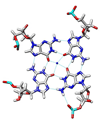2-aminopurine as a probe for quadruplex loop structures
- PMID: 20012419
- PMCID: PMC3008626
- DOI: 10.1007/978-1-59745-363-9_8
2-aminopurine as a probe for quadruplex loop structures
Abstract
Fluorescent reporter groups have served for many years as sensitive probes of macromolecular structure. Such probes can be especially useful in comparative studies such as detection of conformational changes and discrimination among structural models. Spectroscopic methods such as fluorescence are attractive because they are rapid, require small amounts of material, are nondestructive, can be carried out with commonly available equipment, and are relatively inexpensive. In addition, there is a rich library of theoretical and practical materials available to aid in data interpretation.The intrinsic fluorescence of most nucleic acids is too low to be useful in structural studies. Thus, it is necessary to incorporate a suitable reporter group to utilize fluorescence methods involving polynucleotide structure. A highly fluorescent adenine analog, 2-aminopurine, has long served in this capacity. The present article describes our use of 2-aminopurine as a probe of loop structures in quadruplex DNA. In particular, we show how knowledge of the relative intensity of 2-aminopurine emission as well as its sensitivity to exogenous quenching molecules such as acrylamide can aid in comparing crystal and solution structures of an oligonucleotide model of the human telomere and in discrimination among models containing tandem repeats of the telomeric quadruplex.
Figures




Similar articles
-
Not so crystal clear: the structure of the human telomere G-quadruplex in solution differs from that present in a crystal.Nucleic Acids Res. 2005 Aug 16;33(14):4649-59. doi: 10.1093/nar/gki782. Print 2005. Nucleic Acids Res. 2005. PMID: 16106044 Free PMC article.
-
The use of a 2-aminopurine-containing split G-quadruplex for sequence-specific DNA detection.Artif Cells Nanomed Biotechnol. 2018;46(sup3):S950-S955. doi: 10.1080/21691401.2018.1521817. Epub 2018 Oct 12. Artif Cells Nanomed Biotechnol. 2018. PMID: 30314413
-
Simple G-quadruplex-based 2-aminopurine fluorescence probe for highly sensitive and amplified detection of microRNA-21.Talanta. 2018 Feb 1;178:974-979. doi: 10.1016/j.talanta.2017.10.023. Epub 2017 Oct 16. Talanta. 2018. PMID: 29136926
-
Fluorescent probes for G-quadruplex structures.Chembiochem. 2013 Mar 18;14(5):540-58. doi: 10.1002/cbic.201200612. Epub 2013 Feb 25. Chembiochem. 2013. PMID: 23440895 Review.
-
2-Aminopurine as a fluorescent probe of DNA conformation and the DNA-enzyme interface.Q Rev Biophys. 2015 May;48(2):244-79. doi: 10.1017/S0033583514000158. Epub 2015 Apr 17. Q Rev Biophys. 2015. PMID: 25881643 Review.
Cited by
-
Triplex-quadruplex structural scaffold: a new binding structure of aptamer.Sci Rep. 2017 Nov 13;7(1):15467. doi: 10.1038/s41598-017-15797-5. Sci Rep. 2017. PMID: 29133961 Free PMC article.
-
Long promoter sequences form higher-order G-quadruplexes: an integrative structural biology study of c-Myc, k-Ras and c-Kit promoter sequences.Nucleic Acids Res. 2022 Apr 22;50(7):4127-4147. doi: 10.1093/nar/gkac182. Nucleic Acids Res. 2022. PMID: 35325198 Free PMC article.
-
Two-quartet kit* G-quadruplex is formed via double-stranded pre-folded structure.Nucleic Acids Res. 2019 Mar 18;47(5):2641-2653. doi: 10.1093/nar/gky1269. Nucleic Acids Res. 2019. PMID: 30590801 Free PMC article.
-
Cooperative cluster formation, DNA bending and base-flipping by O6-alkylguanine-DNA alkyltransferase.Nucleic Acids Res. 2012 Sep 1;40(17):8296-308. doi: 10.1093/nar/gks574. Epub 2012 Jun 22. Nucleic Acids Res. 2012. PMID: 22730295 Free PMC article.
-
Studies on the Interactions of 3,11-Difluoro-6,8,13-trimethyl-8H-quino[4,3,2-kl]acridinium and Insulin with the Quadruplex-Forming Oligonucleotide Sequence a2 from the Insulin-Linked Polymorphic Region.Molecules. 2021 Oct 30;26(21):6595. doi: 10.3390/molecules26216595. Molecules. 2021. PMID: 34771003 Free PMC article.
References
-
- Wang Y, Patel DJ. Solution structure of the human telomeric repeat d[AG3(T2AG3)3] G-tetraplex. Structure. 1993;1:263–282. - PubMed
-
- Davis JT. G-quartets 40 years later: From 5'-GMP to molecular biology and supramolecular chemistry. Ang. Chem. Inter. Ed. 2004;43:668–698. - PubMed
-
- Huppert JL. Four-stranded nucleic acids: structure, function and targeting of G-quadruplexes. Chem. Soc. Rev. 2008;37:1375–1384. - PubMed
Publication types
MeSH terms
Substances
Grants and funding
LinkOut - more resources
Full Text Sources
Other Literature Sources

